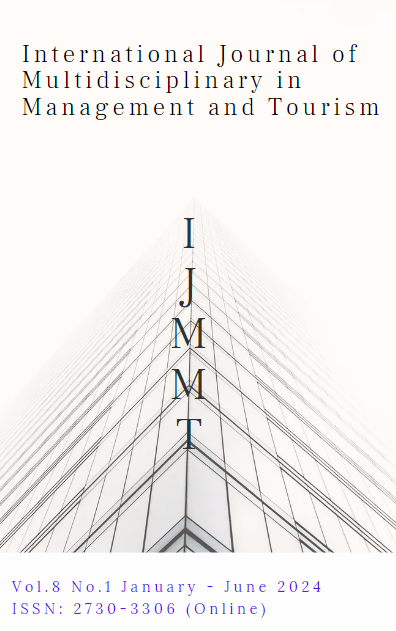Service Quality Improvement and Brand Image of Kulangsu Scenic Spot in Xiamen City, China
Main Article Content
Abstract
Tourism can generate income for every country around the world that has its own unique points of interest. It will make people interested in traveling in that country. Creating a good impression is therefore an issue that every country should focus on. This article aimed 1)To study personal factors affecting the improvement of service quality at Ku Lang Su Scenic Area Spot in Xiamen City 2) To analyze the direct and indirect factors affecting service quality improvement and the brand image of Kulangsu scenic spot in Xiamen City 3) To construct a model to enhance the customer satisfaction and repeat rate of Kulangsu Scenic Spot in Xiamen city. This study is a mixed methods study. and quantitative studies use convenience sampling. The sample group consisted of 560 tourists who visited the Ku Lang Su scenic spot. The tool used to collect data was a questionnaire survey. Statistical data used in this study include percentage, mean, and standard deviation. The research results were found as follows;
1. Personal information of respondents Most of them are female, 292 people. Most of them have an average age of 18-24 years, 264 people. education is at the bachelor's level, 350 people have a career as a student, and 249 people have an income of less than 2000 yuan.
2. The building of brand image has a strong positive correlation with the satisfaction of tourists to the intention of re-visiting and recommending them.
3. The improvement of service quality has a strong positive correlation with tourists' satisfaction to their intention to visit again.
Qualitative research results found that service quality has a positive impact on brand image and customer satisfaction from the perspective of improving service quality and building brand image.
Article Details

This work is licensed under a Creative Commons Attribution-NonCommercial-NoDerivatives 4.0 International License.
References
Aaker, D. A. (1992). The value of brand equity. Journal of Business Strategy, 13(4), 27-32. https://doi.org/10.1108/eb039503
Bitner, M. J. (1992). Services capes: The impact of physical surroundings on customers and employees. Journal of Marketing, 56(2), 57-71. https://doi.org/10.2307/1252042
Cardozo, R. N.(1965). An experimental study of customer effort, expectation, and satisfaction. Journal of Marketing Research, 2(3), 244-249. https://doi.org/10.2307/ 3150182
Huimei, N., Krutasaen, W., & Karnchanapayap, G. (2023). Shiwan Kiln Earthenware Pot Innovation through the Integration of Traditional Kiln Making, Modernity, and Material. Journal of Multidisciplinary in Humanities and Social Sciences, 6(6), 2888–2906. Retrieved from https://so04.tci-thaijo.org/index.php/jmhs1_s/article/view/267 077
Jing, G.(2022). Study on the Effect of Virtual Travel Experience on on-the-spot travel Intention based on SOR Theory. Shanghai Normal University. https://doi.org/10. 27312/d.cnki.gshsu.2022.000210
Kapferer, J. N. (2015). Kapferer on luxury: How luxury brands can grow yet remain rare. Kogan Page Publishers.
Li, Y. X., Kumboon, B., Sajjanan, S., & Prakthayanon, S. (2023). Influence of Employee’s Expectancy to Operational Efficiency of SMEs in Dalian City, The People’s Republic of China. International Journal of Multidisciplinary in Management and Tourism, 7(2), 257–268. https://doi.org/10.14456/ijmmt.2023.17
Luo, B., Wang, H., Liu, H., Li, B., & Peng, F. (2018). Early fault detection of machine tools based on deep learning and dynamic identification. IEEE Transactions on Industrial Electronics, 66(1), 509-518.
Luo, Z. (2001). Composition and measurement of brand image. Beijing Technology and Business University Journal (Social Sciences), 7, 19-22.
Sasser, W. E., Olsen, R. P., & Wyckoff, D. D.(1978). Management of service operations: text, cases, and readings. Allyn and Bacon.
Teas, R. K. (1993). Expectations, performance evaluation, and consumers' perceptions of quality. Journal of Marketing, 57(4), 18–34. https://doi.org/10.2307/1252216
Wenxiong, L., & Yifan, C.(2017). Based on visual marketing enterprise brand image shaping. Journal of Business and Management, 396(6), 132-134. https://doi.org 10.16517/j.carolcarrollnki n12-1034/f 2017.06.038.
Yilin, Q.(2019). Strengthen brand construction, improve development quality and enhance enterprise strength. salt industry in China, 340(13): 32-34. https://doi.org 10.19396/j.carol carrollnkiissn1004-9169.2019.13.008.
Zeithaml, C. P., & Fry, L. W.(1984). Contextual and strategic differences among mature businesses in four manic performance situations. Academy of Management Journal, 27(4), 841-860.
Zhang, W., Yi, Z., Huang, J., Li, F., Hao, B., Li, M., Hong, S., Lv, Y., Sun, W., Ragauskas, A., Hu, F., Peng, J., & Peng, L. (2013). Three lignocellulose features that distinctively affect biomass enzymatic digestibility under NaOH and H2SO4 pretreatments in Miscanthus. Bioresource technology, 130, 30-37. https://doi.org/10.1016/j.biortech. 2012.12.029
Ziying, G.(2022). Study on the Effect of Short Video Marketing on Consumers' Purchase Intention Based on SOR Theory. Central China Normal University. https://doi.org/10. 27159/dcnki.ghzsu.2022.000954.

